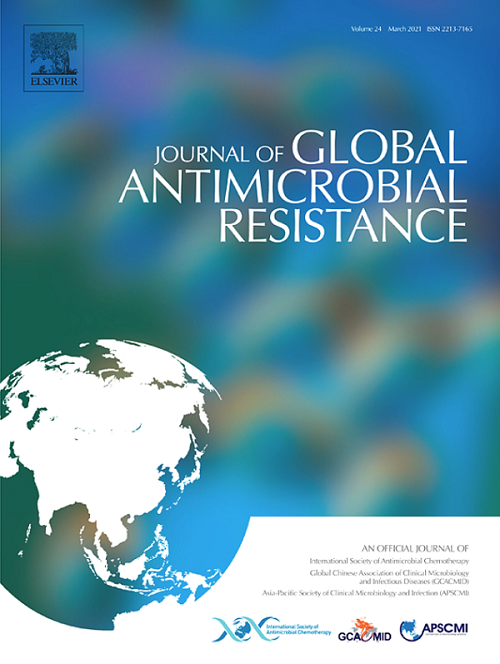Blood isolates of Serratia marcescens: Antibiotic susceptibility patterns and genetic determinants of carbapenem and aminoglycoside resistance
IF 3.7
3区 医学
Q2 INFECTIOUS DISEASES
引用次数: 0
Abstract
AIM AND BACKGROUND
Serratia marcescens have been identified as a significant pathogen associated with sporadic infections or outbreaks, especially in pediatric patients and those in intensive care units (ICUs). In this study we aimed to determine antibiotic susceptibility patterns and genetic determinants of drug resistance in invasive S. marcescens isolates.
METHODS
A total of 98 non-duplicate strains of S. marcescens isolated between 2019 and 2023 from positive blood cultures in our hospital were included. In vitro susceptibilites of the isolates to 19 antibiotics from major classes of antibiotics (beta-lactams, cephalosporins, carbapenems, quinolones, aminoglycosides, trimethoprim-sulfamethoxazole) were studied by disk diffusion method (EUCAST v 14.0). Extended spectrum beta-lactamase (ESBL) and carbapenemase production were tested according to EUCAST v 14.0. Genetic determinants of carbapenem resistance were investigated by PCR. Carbapenem and aminoglycoside resistant isolates were sent for whole genome sequencing (WGS) for further genetic analysis.
RESULTS
Majority of the isolates were from adults (75.5%) in ICU. High rates (≥90%) of susceptibility were recorded for third generation cephalosporins, cefepime, ceftazidime-avibactam, ceftolozane-tazobactam, carbapenems, aminoglycosides, quinolones and trimethoprim-sulfamethoxazole. In contrast, low susceptibility rates for cefoxitin (46%) and amoxycillin-clavulanic acid (3%) were observed. Among three carbapenem resistant isolates, one was found positive for blaOXA-48 gene in PCR. WGS and data analysis are currently ongoing.
CONCLUSION
Our results are encouraging in that they show that antibiotic resistance in our isolates is not at threatening levels. However, it would be meaningful to reveal the genetic basis of resistance in resistant isolates, even if they are few in number..
求助全文
约1分钟内获得全文
求助全文
来源期刊

Journal of global antimicrobial resistance
INFECTIOUS DISEASES-PHARMACOLOGY & PHARMACY
CiteScore
8.70
自引率
2.20%
发文量
285
审稿时长
34 weeks
期刊介绍:
The Journal of Global Antimicrobial Resistance (JGAR) is a quarterly online journal run by an international Editorial Board that focuses on the global spread of antibiotic-resistant microbes.
JGAR is a dedicated journal for all professionals working in research, health care, the environment and animal infection control, aiming to track the resistance threat worldwide and provides a single voice devoted to antimicrobial resistance (AMR).
Featuring peer-reviewed and up to date research articles, reviews, short notes and hot topics JGAR covers the key topics related to antibacterial, antiviral, antifungal and antiparasitic resistance.
 求助内容:
求助内容: 应助结果提醒方式:
应助结果提醒方式:


